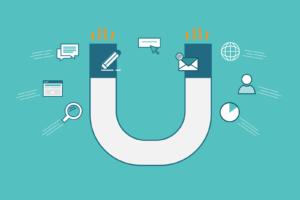
The purpose of inbound marketing is to attract your potential customers by offering them relevant, truly useful content that helps them understand and solve their problems throughout their buyer’s journey. The buyer’s journey consists of awareness, consideration and decision stages, and your goal is to guide a prospect through these stages.

HubSpot - the global inbound marketing platform - now goes with three stages: attract, engage and delight, which you can see illustrated below in their flywheel (their sales funnel replacement model).

We don’t have a problem with this representation, but addressing four distinct stages can help to illustrate how the inbound marketing process works. It lets us dig into the engage stage and explore the best tactics to convert and close, as well as attract and delight.
These labels describe quite clearly the intention of inbound marketing efforts at these stages: attracting new visitors to your website; converting those visitors into leads; closing those leads with a sale or sign-up; and finally delighting those customers with top-notch service to turn them into return customers and brand promoters.
Let’s take a closer look at these stages and explain them in a little more detail, while also examining the best inbound marketing tactics to use at each stage.
Stages of the inbound marketing methodology
Attract
If you want to run a successful online business you need to attract new visitors via your website. If you want to see business growth in the 21st century, driving new traffic to your site is absolutely vital and it’s no doubt one of your goals if you’re reading this article. One of the benefits of inbound marketing is that when done well it can help you do just that.
So you want to attract more traffic, but you don’t want just anyone turning up on your website. You want the right kind of people, who are likely to become leads and, hopefully not too far down the line, customers. But how do you get the right kind of visitors?
Simple - with the right kind of content. If you create content designed to help your ideal customer, content that is relevant to what you offer and useful to that ideal customer, at whatever stage of the buyer’s journey they are at, you will have a very good chance of attracting the right kinds of visitors. Before you get to work on this content you should make sure you have worked on some buyer personas. These are semi-fictional representations of your ideal customer, and they will help you target the right people, and understand what they are looking for.
Your content should answer questions and show potential customers how to solve their problems, and if at all possible your content should be the most comprehensive piece on the market. You also need to make this content available to prospects at the right time - which is when they need it! You need to make sure your content is published on the right media for your target audience too. Again, buyer personas should help here.
Tactics and tools to employ:
-
- SEO - to build your visibility in organic search results by improving rankings for relevant search terms, thereby driving more traffic your way
- PPC - to gain additional exposure and complement your other inbound efforts in attracting new traffic to your site
- Social media - to amplify your content, increasing your exposure further, while providing a simple way to interact with prospects and build brand trust
- Blogging - to attract new visitors by offering comprehensive posts that will help your ideal customers
- Buyer personas - to help you identify your ideal customers and target them with your inbound marketing strategy
Convert
Inbound marketing can attract and convert visitors landing on your website. But how exactly do you turn your new traffic into leads? A prospect becomes a lead when they engage with your website and share some of their information with you.
To encourage this you need to allow visitors to engage in a way that suits them (see buyer personas again). Thankfully there are numerous ways to do this, such as live chat, capture forms and more (see below).
Once you have encouraged a visitor to engage, you are in a position to nurture that new lead by responding to any queries they have and by offering more relevant content to help them move along their buyer’s journey. A real benefit of the inbound marketing process is that the leads you get will already be qualified when they engage with you, because they have found you through relevant content. This saves valuable time filtering out leads who are unlikely to become customers.
A CRM (customer relationship management) system is also vital so that your entire team - whether sales, customer service or marketing - can keep track of your leads and all communications you have with them. Want to know more about CRM? Check our our comparson article on HubSpot vs Salesforce - two of the main players in the market. We lean towards the former and have become a HubSpot agency partner, but decide for yourself.
Tactics and tools to employ:
- Content offers - to guide visitors with educational assets, in order to move them along their buyer’s journey
- Meetings - to give prospects a chance to easily book a meeting with someone on your team
- Calls to action - to induce a prospect to engage with you, so they become a lead
- Landing pages - to capture information from potential customers. Landing pages often host content offers such as ebooks or free trials
- Email capture - to capture a prospect’s information via pop-ups, often featuring content offers or suggestions for a visitor to subscribe to a mailing list
- Chatbots - to give prospects an easy way to engage with your website immediately
Close
This is the stage where you turn your warm lead into a customer. You do this simply by helping to solve their problem, with both helpful content and excellent customer service.
Your lead should now be at the consideration or even decision stage of their buyer’s journey, so you need to offer all the help you can to help them find the right solution to their problem, and how they can acquire that solution. This might mean offering a blog post comparing a couple of different products (consideration stage), or a video on the best ways to use a specific product the customer has realised would benefit them (decision stage).
There are numerous tactics that you can use to nurture leads and encourage them to become customers.
Tactics and tools to employ:
- Email - to build trust and nurture leads to become customers, using a series of emails offering helpful, relevant content
- Marketing automation - to automate repetitive marketing tasks such as social media posts and sequence emails, to save your team time and money
- CRM integration - to enable you to track the history of your customer interactions, including page views, emails opened, calls and much more
- Sales alignment - to get your sales, marketing and customer service teams working together, with all able to see the same information in order to provide a great customer experience
- Reviews - to give real world evidence that encourages leads to become customers
- Testimonials - again, to show that real people with the lead’s problem would recommend a product or service
Delight
Delighting customers is something that you have to consider at every stage of the inbound process. This means from the moment they visit your site all the way through to them becoming a customer, and beyond.
Retaining customers and creating brand promoters is not easy, which is why this has to be at the front of your mind as you are creating content, answering queries, responding to mentions on social media and following up with existing customers.
Why is delighting customers so important? Because a business’ reputation is vital for its growth. Customer experiences are easily accessible in the form of reviews and testimonials, and if they don’t look good, your business is likely to struggle. So going above and beyond, and delivering a human, helpful experience is well worthwhile and a key aspect of success as a digital enterprise. Do it right and you have a good chance of keeping your customers and driving new traffic to your site.
Tactics and tools to employ:
- Customer service programmes - to set out the standards expected from everyone in your team, in order to maximise the chance of great customer experiences
- Referral programmes - to get happy customers to promote you post-sale. Such programmes offer incentives such as discounts to the customer and anyone they refer
- Feedback - to gain valuable insight from your customers, which you can use to improve your inbound strategy. Feedback can be gained through emails, calls, meetings and surveys
Here are some inbound marketing examples to give you a little more inspiration and to show how these tactics and tools can be used to great effect.
Find new customers with inbound
Hopefully you now have a good understanding of the inbound marketing process, and how this methodology can help your business grow online.
If you’re considering using a UK-based inbound marketing agency to help boost your digital presence – whether that’s us or someone else – our posts on what to expect from an inbound consultation and questions to ask while you’re there, might prove useful.
And you’d like to discuss your specific needs feel free to contact us, download our credentials deck for more info, or hit the button below to book a free inbound marketing consultation.








